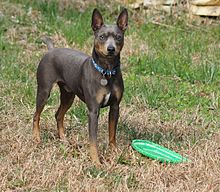American Hairless Terrier
The American Hairless Terrier is a breed of dog that was formerly considered a variant of Rat Terrier. As of January 1, 2004, the United Kennel Club deemed the AHT a separate terrier breed. An intelligent, social and energetic working breed, the American Hairless Terrier is often listed as a potential good breed choice for allergy sufferers.
History
The American Hairless Terrier's American ancestry begins with the mixed breed terriers called Feists brought from Europe to the North America as early as the 18th century. In the late 1800s the Rat Terrier breed was developed from the Feist by the addition of Beagle, Italian Greyhound and Miniature Pinscher bloodlines.
The distinct American Hairless Terrier breed began in 1972 when one hairless puppy named Josephine appeared in a Rat Terrier litter in the state of Louisiana, United States. Owners Edwin and Willie Scott liked the dog's look and temperament, and upon maturity bred her hoping to reproduce the hairless quality. They were eventually successful; a litter produced in 1981 provided the foundation stock of the breed.
Breed recognition
In 1998 the breed gained recognition as the American Hairless Terrier by the American Rare Breeds Association and the National Rat Terrier Club. Canada was the first country outside the US to gain recognition, by Canadian Rarities in 1999. In 1999 the breed was recognized as Rat Terrier, Hairless Variety by the United Kennel Club.
In the U.S., the American Hairless Terrier Association is the provisional breed club. Other National Breed Clubs around the world include the Canadian American Hairless Terrier Association and the Japanese Hairless American Terrier Club.
On January 1, 2004, the United Kennel Club (UKC) recognized the American Hairless Terrier as a distinct breed.[1]
The American Kennel Club (AKC) also includes the American Hairless Terrier within its Foundation Stock Series and allows them to participate in AKC Performance events and in Open shows.
Despite its smaller size the AHT is not a toy breed. Rather, like its Rat Terrier cousin, the AHT is a working breed.
Coated American Hairless Terrier
In its 2006 description, the UKC continued to recognize the hairless and coated varieties of the American Hairless Terrier noting that "[w]hile it may seem contradictory to have coated dogs in a
hairless breed, it will be necessary for the foreseeable future to continue to include some Rat Terrier crosses until there are sufficient hairless dogs to maintain a separate
and healthy gene pool".[2]
Description
The American Hairless Terrier is a smoothly muscled, active, small-to-medium terrier.
Height: 7-18 inches (18–45.7 cm.)
Life Span: 14-16 years.
Life Span: 14-16 years.
Weight: 7-25 pounds (2.5–12 kg.)
Skin Color: White (to varying degrees) with a variety of colors including black, blue, pink, brown, tan, and sable. Skin color darkens with sun
Eye Color: Brown, blue, grey, amber and turquoise
Pattern: near-solid (with some white), brindled, spotted (piebald) and saddled
Tail/Ears: Tails must be left long on the hairless variety, coateds may be docked or left undocked
Type: Working Breed
Skin Color: White (to varying degrees) with a variety of colors including black, blue, pink, brown, tan, and sable. Skin color darkens with sun
Eye Color: Brown, blue, grey, amber and turquoise
Pattern: near-solid (with some white), brindled, spotted (piebald) and saddled
Tail/Ears: Tails must be left long on the hairless variety, coateds may be docked or left undocked
Type: Working Breed
American Hairless Terrier and Rat Terrier distinctions
The American Hairless Terrier's origins are unique in that the entire breed originated from a single hairless Rat Terrier female born in 1972. The AHT is therefore very similar to the Rat Terrier and the coated AHT is almost indistinguishable from its Rat Terrier cousin.
However, since the first litter born in 1982 from the originating hairless female, the AHT has continued to be developed as a distinct breed (see "Breed Recognition") with several characteristics that distinguish the AHT from its Rat Terrier origins. These differences include smaller sizes, more refined features, new eye colors, new patterns, new (skin) colors and, of course, a complete lack of fur on the hairless variety.
Other breeder choices have further differentiated the AHT. AHT breeders and clubs promote the undocked tail appearance on hairless, unlike the more traditionally docked appearance of the Rat Terrier. To date, the hairless trait has not been bred over to the other types of Rat Terrier such as the Giant Decker Rat Terrier or the Type B Rat Terrier (also known as the Teddy Roosevelt Terrier).
Hairless breeds and genetics
While there are unproven theories that other hairless dog breeds have common ancestry, the recent evolution of the American Hairless Terrier demonstrates an independent evolution from other hairless breeds.
A key difference found between the American Hairless Terrier and other Hairless Dog breeds is that the AHT's hairless gene is recessive, while the gene for hairlessness found in the ancient breeds is a lethal dominant.
The American Hairless Terrier does not have dental issues (absent premolars) or other characteristics associated with the dominant hairless gene.
For dogs where hairlessness is a dominant gene, hairless to hairless matings will on average produce 66.6% hairless and 33.3% coated puppies. For hairless to coated matings, there will be an average of 50%/50% coated to hairless ratio, while for coated to coated matings, all puppies will be coated.
Matings between hairless AHTs will produce completely hairless litters while hairless AHT to coated AHT or Rat Terrier are more variable and will produce mixed hairless litters to all coated litters.
 | ||||||||||||||||
| an American Hairless Terrier | ||||||||||||||||
| Nicknames | AHT | |||||||||||||||
|---|---|---|---|---|---|---|---|---|---|---|---|---|---|---|---|---|
| Country of origin | United States | |||||||||||||||
| ||||||||||||||||
| ||||||||||||||||




No comments:
Post a Comment